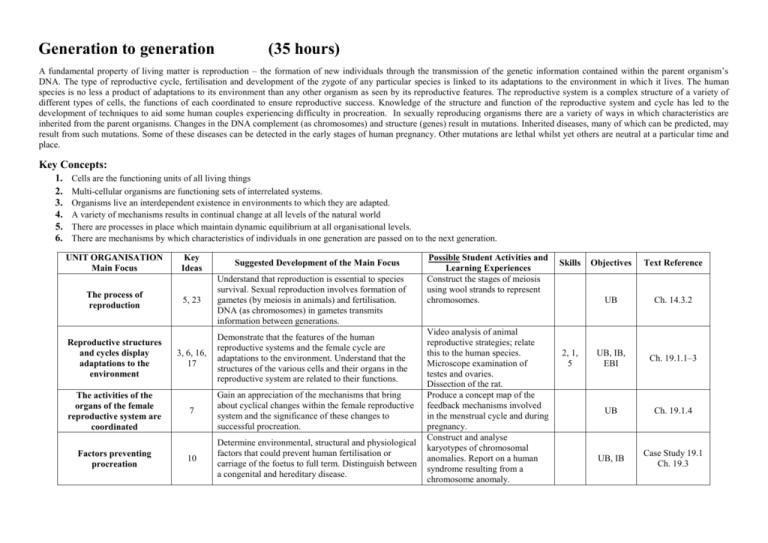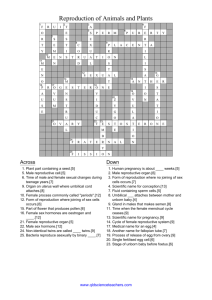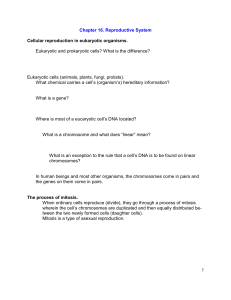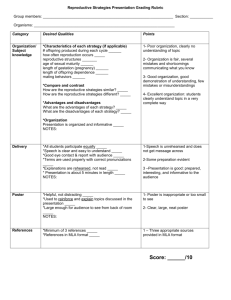“What is that, where is it found and why can it live there
advertisement

Generation to generation (35 hours) A fundamental property of living matter is reproduction – the formation of new individuals through the transmission of the genetic information contained within the parent organism’s DNA. The type of reproductive cycle, fertilisation and development of the zygote of any particular species is linked to its adaptations to the environment in which it lives. The human species is no less a product of adaptations to its environment than any other organism as seen by its reproductive features. The reproductive system is a complex structure of a variety of different types of cells, the functions of each coordinated to ensure reproductive success. Knowledge of the structure and function of the reproductive system and cycle has led to the development of techniques to aid some human couples experiencing difficulty in procreation. In sexually reproducing organisms there are a variety of ways in which characteristics are inherited from the parent organisms. Changes in the DNA complement (as chromosomes) and structure (genes) result in mutations. Inherited diseases, many of which can be predicted, may result from such mutations. Some of these diseases can be detected in the early stages of human pregnancy. Other mutations are lethal whilst yet others are neutral at a particular time and place. Key Concepts: 1. 2. 3. 4. 5. 6. Cells are the functioning units of all living things Multi-cellular organisms are functioning sets of interrelated systems. Organisms live an interdependent existence in environments to which they are adapted. A variety of mechanisms results in continual change at all levels of the natural world There are processes in place which maintain dynamic equilibrium at all organisational levels. There are mechanisms by which characteristics of individuals in one generation are passed on to the next generation. UNIT ORGANISATION Main Focus The process of reproduction Reproductive structures and cycles display adaptations to the environment The activities of the organs of the female reproductive system are coordinated Factors preventing procreation Key Ideas Suggested Development of the Main Focus 5, 23 Understand that reproduction is essential to species survival. Sexual reproduction involves formation of gametes (by meiosis in animals) and fertilisation. DNA (as chromosomes) in gametes transmits information between generations. 3, 6, 16, 17 Demonstrate that the features of the human reproductive systems and the female cycle are adaptations to the environment. Understand that the structures of the various cells and their organs in the reproductive system are related to their functions. 7 Gain an appreciation of the mechanisms that bring about cyclical changes within the female reproductive system and the significance of these changes to successful procreation. 10 Determine environmental, structural and physiological factors that could prevent human fertilisation or carriage of the foetus to full term. Distinguish between a congenital and hereditary disease. Possible Student Activities and Learning Experiences Construct the stages of meiosis using wool strands to represent chromosomes. Video analysis of animal reproductive strategies; relate this to the human species. Microscope examination of testes and ovaries. Dissection of the rat. Produce a concept map of the feedback mechanisms involved in the menstrual cycle and during pregnancy. Construct and analyse karyotypes of chromosomal anomalies. Report on a human syndrome resulting from a chromosome anomaly. Skills 2, 1, 5 Objectives Text Reference UB Ch. 14.3.2 UB, IB, EBI Ch. 19.1.1–3 UB Ch. 19.1.4 UB, IB Case Study 19.1 Ch. 19.3 Generation to generation Continued UNIT ORGANISATION Main Focus Key Ideas Reproductive technologies 18 Examine some of the technologies available to assist couples overcome problems in becoming parents. 22, 23 Gain an appreciation of the significance of Mendel’s work and the development of his principles. Explain how this work is related to the formation of gametes and the modern concept of the gene. 22, 23 Understand that many inherited characteristics come about by the mechanisms of intermediate dominance, co-dominance, multiple alleles, continuous variation, modifier genes and sex-linked genes. Distinguish between autosomes and sex chromosomes. 10, 18, 22, 23 Develop an understanding of some human genetic diseases, their cause and possible pattern of inheritance. Examine the process of genetic counselling and possible means of detecting the disease. Genes, sections of the DNA of chromosomes, determine characteristics Non-Mendelian genetics Human genetic diseases Suggested Development of the Main Focus Possible Student Activities and Learning Experiences Produce a newspaper report on the available reproductive technologies and comment on their ethical application. Experimental investigation of Mendelian inheritance using first and second-hand data. Calculations of results of possible crosses. Design and carry out an investigation to determine if a human trait is sex-linked or autosomal, dominant or recessive. Calculations of possible crosses. Individual students to investigate a specific human inherited disease; results to be pooled and a class chart produced. Objectives Text Reference UB, EBI Ch. 19.3.3 Ch. 24.2 6 UB, IB Ch. 20.1 6 UB, IB Ch. 20.2 Ch. 20.3 UB, IB Ch. 20.5 Skills







